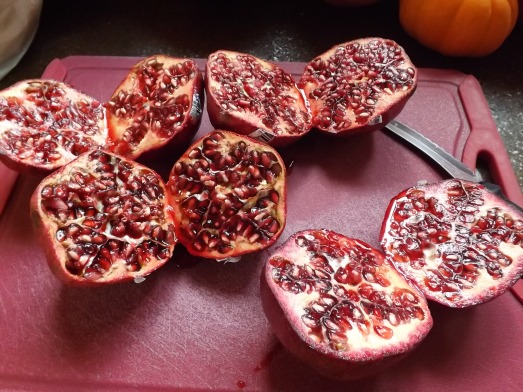There is something to be said for too much of a good thing. The other day while grocery shopping, I just happen to be strolling by the discount produce rack (and I do say strolling by — not making a bee-line for the discount rack the minute I get in the store, shoving anyone who got in my way to the ground) and was thrilled to find three full racks. It was a dream come true!
One rack was filled with lemons, limes, and oranges all at ridiculously discounted prices. Every bag of lemons and limes went into my cart. The next rack was filled with avocados. I had enough of this in the freezer, so as difficult as it was, I had to pass it by. The third, well, they saved the best for last — a rack full of bags of pomegranates for $.25 each. I couldn’t pass that up — every bag that wasn’t oozing juice from seriously overripe pomegranates went into my cart.
Last year I made pomegranate jelly and it was a real hit. This year, I had other plans. First and foremost though I had to clean them. Seeding a pomegranate is one of those tasks that I do not look forward to. Sure I’ve researched on the Internet all the claims of “easy” methods to seed one of these, and for the most part, about the only one I would recommend would be the underwater method. It cuts down on the juice making a mess and does make the deed a bit more tolerable, but as for the juicing, there was nothing that sounded the least bit “easy.”
Every site I visited for “juicing” a pomegranate first offered their own “easy” method to seed it. My favorite had to be the guy who claimed he could seed one in less than 10 seconds by whacking it with a wooden spoon. I tell you what, if I’m going to whack a pomegranate, it ain’t going to be to get seeds out of it and there probably wouldn’t be much of it left by the time I got done with it. Whacking it! I don’t think so.
Not finding anything that would miraculously make the task before me “easy,” I set to work seeding the fruit using the underwater method. I got to the third one and was done. I’d had enough. Honestly I’m not lazy, I just didn’t have time for this. There were pumpkins to can, the last batch of jalapeno peppers from the garden, the final beet harvest, sauerkraut to make, and the best news of all…cranberries are back in season and I have tons of recipes I’m dying to try. Spending a few hours seeding the 20+ pomegranates on the counter, was not an option.
Standing there at the counter, staring at the fruit I’d bought — a huge bowl filled to the brim with lemons and limes and a counter full of pomegranates, inspiration hit. Why not juice the pomegranates the same way I juice my lemons and limes. What’s the worst that could happen? I could get the job done in record time with minimal mess and even less effort. I had to try it.
I pulled out my handy-dandy juicer. I don’t have one of those wonderfully complex machines that you feed your fruit into one end and a perfect juice comes out the other. No, I’m a bit more of a hands-on type of gal. I’ve got a hand-me-down juicer that my father gave me about 10 years ago. It has juiced more lemons, limes, oranges, and grapefruit than I care to remember and is still going strong (knock on wood).

Next I sliced all the pomegranates in half. This was pretty messy, but expected.

Then I took one of the halves and placed it on the juicing part (I’d get more technical here, but I have no idea what you’d call that thingy on top that does all the work) and pressed down. Within 15 seconds I could feel that the pulp was gone inside the pomegranate shell. Looking into the base of the juicer, I had juice and in the top were a bunch of white seeds. Wow! Talk about easy.


It took me about 10 minutes to juice every one of my pomegranates and had about 10 cups of juice. Had I opted to seed and then juice, I’d probably still be working on them. As it is, I finished the juicing, made a batch of pomegranate syrup and a batch of pomegranate-lemonade concentrate (recipes to follow shortly) and started working on my pumpkins.

Just a portion of the juice I ended up with.
Now, if you are the type of person who wants that crystal clear juice that they sell in the stores, this is definitely not going to be for you. This method gets almost all of the juice, without regard for how cloudy it is. Most of my jams and jellies are cloudy because I want some substance in there, not just the crystal clear juice. I believe that there are a lot of nutrients lost when you strain every bit of pulp from the juice. I’m not going for blue ribbons here, just good tasting, healthy food.
Also, being a waste-not-want-not type of gal, I couldn’t leave the seeds with the little bit of pulp on them go to waste. I decided to heat them so more of the juice could release and ended up with another two cups of juice.
This slideshow requires JavaScript.
I love being able to find new ways to make my life easier, especially when it involves using a favorite gadget, and for this I am — Simply Grateful.







